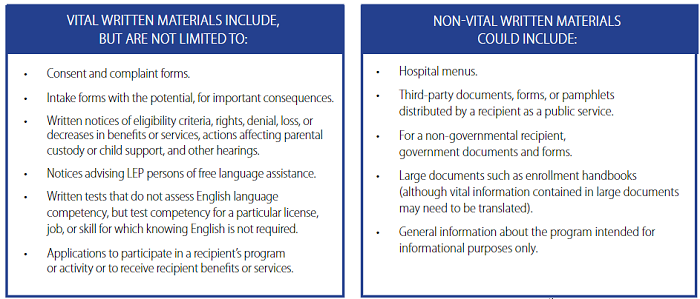
The material herein is educational and informational only. No legal advice is provided
You’ve considered the patients themselves when it comes to translating discharge instructions, but have you considered their caretakers?
Recently a patient sued a Texas hospital system, alleging that the hospital violated the Affordable Care Act’s prohibition on national origin discrimination when it did not translate the discharge instructions for the patient’s caretaker, his young son who also did not speak English well.
The instructions were written in English—a language the son providing the patient’s post-discharge care couldn’t read. The patient alleged that this oversight was the reason for his stroke less than a week after he was discharged.
Section 1557 and Lawsuits
Section 1557 of the Affordable Care Act enables patients to sue providers for unintentional, or “disparate impact” discrimination, which includes on the basis of race, color, or national origin (including immigration status and English language proficiency). Section 1557 applies to “every health program or activity,” that receives Federal financial assistance.
While this lawsuit seems to be the first case against a provider since the law was enacted, more suits may soon follow.
How to Keep Your Organization Compliant
When and how should you use document translation in your organization? Luckily, the Department of Justice created a Four-Factor Analysis to help you determine which documents you should have translated, by whom, and into which languages. The Four Factor Analysis is as follows:
- The number or proportion of limited-English proficient persons eligible to be served or likely to be encountered by the program or grantee. According to the Office of Civil Rights’ Safe Harbor rules, written translation of vital documents are necessary if an LEP population reaches five percent of the surrounding community, or if the number of LEPs reaches 1,000 people or more – whichever is less.
- The frequency with which limited-English proficient (LEP) individuals come in contact with the program. As with point one, remember to take into account both the number of LEPs in the surrounding area and the actual number of LEPs in the hospital. This will also help you determine which languages to translate your notices and signage that explain the availability of language services in the state’s top 15 non-English languages, as mandated by 1557. HHS provides the top 15 non-English languages per state as a place to start here.
- The nature and importance of the program, activity, or service provided by the program to people’s lives. With that in mind, here are some potential examples of vital and non-vital documents:

- The resources available to the grantee/recipient and costs
If you come across a similar scenario as the above case where your providers think that discharge papers may need to be translated into an additional language for the sake of the caretaker’s understanding, CyraCom has the ability to support your translation needs. We offer translation services for over 150 languages, a secure customer Portal, and a quick turnaround option, so your patients and potential non-English-speaking caretakers can have the information they need when they need it.
By taking the necessary steps to provide meaningful access to limited-English proficient individuals, you’ll be helping to keep your organization compliant and lower your risk of litigation.
Want to Learn More About what the ACA requires? Go to www.cyracominternational.com/aca-section-1557










